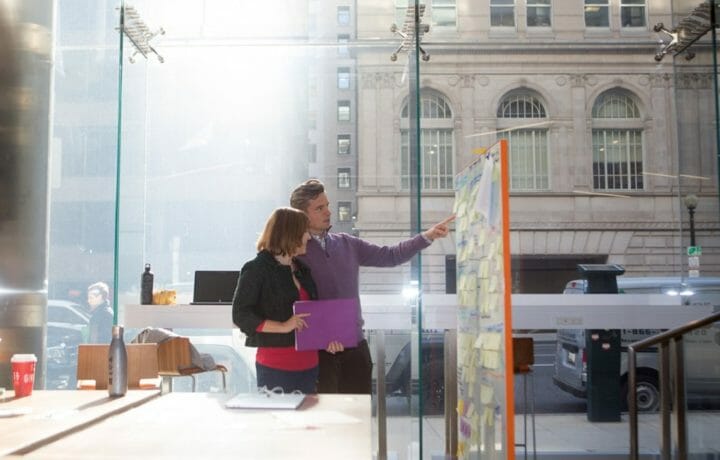Booz Allen shares advice on how federal leaders can create a culture of innovation within the government.
Written by Ben Marglin and Nyla Beth Gawel
Today’s agency leaders are challenged to be faster, more efficient, and more sophisticated—potentially with fewer resources. With the recent release of the Administration’s overarching plan for government reform, the pressure continues to grow.
While this environment can be a source of frustration, it’s actually one ripe for innovation because with pressure comes possibility. It’s precisely in this moment of reorganization that leaders should seek opportunities to embed innovation into the employee culture.
Before we review our advice for how leaders can do this, let’s be clear about what innovation isn’t, because many people get stuck right there. Innovation is not:
- A program with set resources
- A time-bound activity with a deadline
- A single invention or change
Looking at our most successful clients, it’s clear that innovation is a cultural mindset—an embedded tolerance to push boundaries, experience setbacks, and apply lessons for the next uphill climb.
So if innovation is a fundamental willingness to evolve, where do you start?
This summer, we teamed with the Partnership for Public Service to host a roundtable session where 23 senior government executives unpacked this thorny concept of innovation. Participants representing 12 different departments and agencies engaged in dynamic problem-solving exercises on topics such as incentivizing innovation, piloting ideas, collaborating across government, and sustaining success.
Attendees sat in on a panel with government leaders who shared their own personal experiences when pushing for innovation, and who offered the following advice for others in the same situation:
- Break out of your four walls. While we’re seeing exciting pockets of innovation spring up throughout the government, there’s an increasing need for collaboration between organizations, especially now that we have clear cross-agency priority goals. Instead of innovating in a vacuum, seek partners to advance a common mission. Panelist Eddie Hartwig, deputy administrator for the U.S. Digital Service, shared an example of how one citizen engaged with multiple agencies in order to obtain a visa, as well as a marriage license. While there are multiple organizations involved in these processes, there is only one customer, which creates a need for agencies to innovate together.
- Don’t be constrained by the current reality. Panelist Thomas Debass, acting special representative for global partnerships at the U.S. Department of State, encouraged participants to consider how to get something done, not just whether there’s a past precedent to follow. There will always be bureaucratic barriers to innovation at any large organization, so persistence in communicating an idea is critical. Also, understanding that not every idea is equal, be conscious that constructive feedback towards employees—versus a green light—is sometimes the best way to encourage iterative improvement.
Only 31 percent of 2017 Federal Viewpoint Survey respondents said that creativity and innovation are rewarded at their agencies. That’s among the 10 most negative responses in last year’s survey. Mariela Melero, associate director of customer service and public engagement at U.S. Citizenship and Immigration Services, explained that innovators need to be given space to be creative and drive change. She suggested helping employees be creative by providing them with top cover should their ideas fail, serving as a sounding board for ideas, and helping to champion the most viable ones.
We know that risk taking does not come naturally to the Federal Government. But to drive meaningful change, agency leaders must make it clear that innovation at all levels—and even a healthy amount of failure—is strongly encouraged to better achieve the mission of serving citizens.
Allow Space for Controlled Failure
At Booz Allen, we’ve addressed similar challenges. A few years ago, we knew we needed to hire new and different skill sets, and take more risks to meet our mission. At the most basic level we developed our Innovation Center, a “safe” collaboration space designed to make day-to-day operations much different for employees tasked with some of our most forward-thinking projects.
As a reminder that failure is part of the journey to success, our first chief innovation officer gave out “get out of jail free” cards, encouraging employees to embrace mistakes during their time at the Innovation Center. This increased tolerance for trial and error helped transform our culture.
There’s no question that government employees want to innovate: 91 percent of employees who took the Federal Viewpoint Survey reported “I am constantly looking for ways to do my job better.” The trick is helping leaders recognize great ideas and find ways to act on the best ones. If you don’t experience failures as a government leader, it likely means you’re not taking the risks necessary to advance the mission that brought you here.
For more on this topic, watch Ben, Nyla Beth, and Meroe Park from the Partnership for Public Service, discuss innovation in government.
Would you like to join this team of innovators? Check out Digital and Cloud positions at Booz Allen here.
SPONSORED CONTENT: This article is written by or on behalf of our Sponsor.


